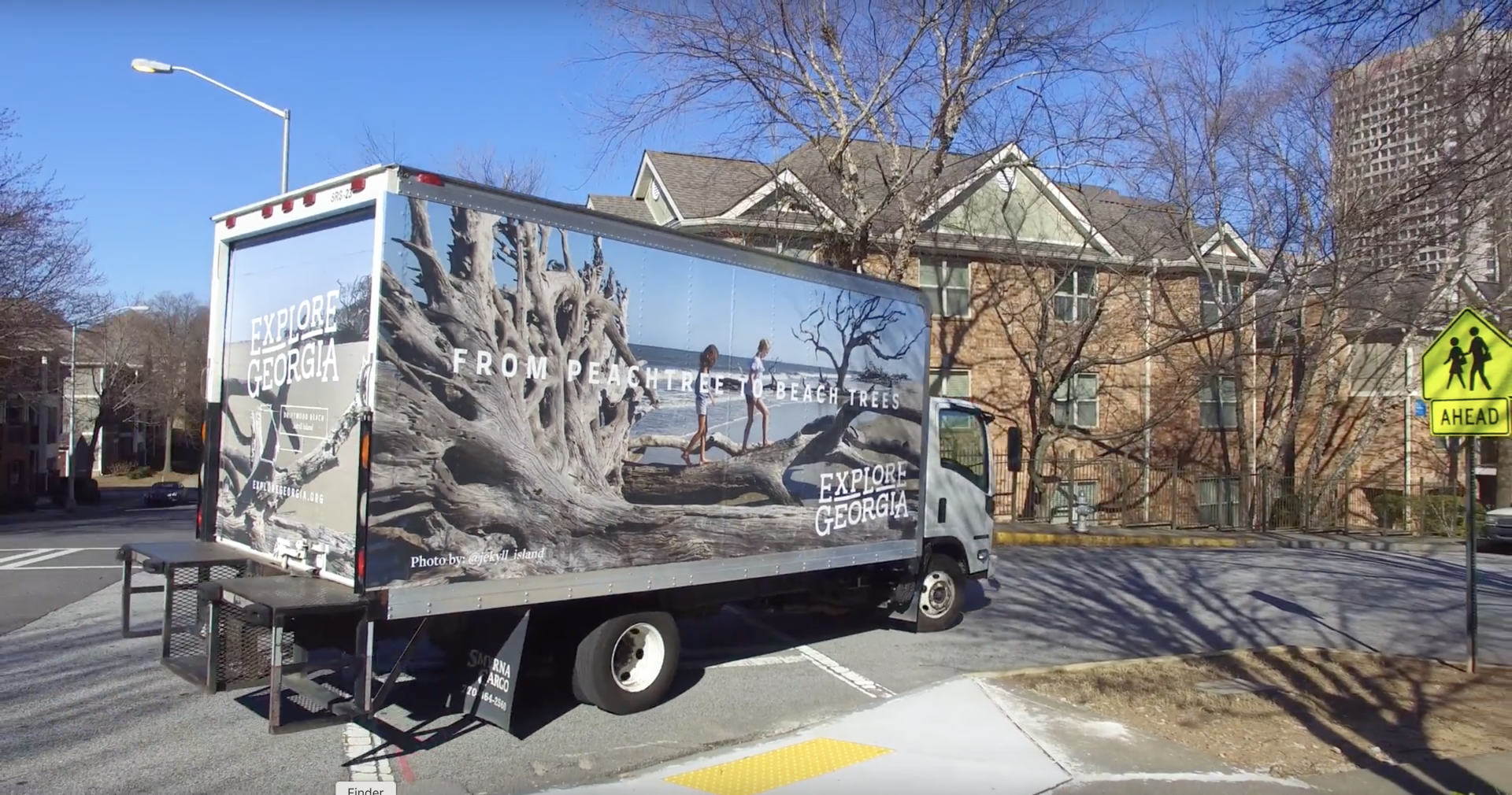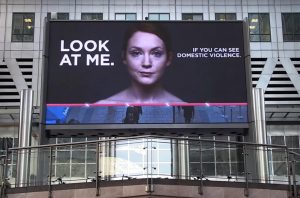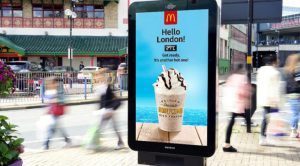The incredible resilience of OOH
by courtney_bachar | 8 December 2021 11:02 am

An example of truck-side advertising. Photos courtesy Casey Binkley
By Casey Binkley
No one can argue that as consumers took to their couches during the pandemic, things did not look good for Out-of-Home (OOH) advertising. However, consumers quickly adapted, finding enjoyment and a break from routine, in being outside. Once vaccines and summer arrived, streets began to fill up and feel livelier. In the meantime, OOH advertisers took the year to rethink the way they design and launch their campaigns to reach audiences in new and more effective ways.
In fact, according to GlobeNewswire, with the advancement of some industry developments and trends, the future of OOH looks bright. Revenue is expected to increase rather quickly over the next couple of years—reaching $81.35 billion by 2023.
So, what makes OOH stand out in the new world we live in? What makes it innovative and exciting to potential clients, advertisers, and consumers?
OOH creates brand awareness and engagement
For brands looking to penetrate the market, OOH is a great way to get people’s attention. An ad viewed once on another medium may have very little impact, but an OOH ad that meets the eyes of a mass audience for days, weeks, and months, often resonates in a more powerful way. As brand awareness is built, people begin to engage—they seek to find out more, or even talk about the product or message with friends. The size and prevalence of the ads also helps build trust, an important factor as consumers move further along the purchase funnel.
OOH triggers purchase decisions
OOH is the dominant choice of medium when advertisers want to influence consumers before making their purchase. It helps distill and deliver the message using memorable, key factors. These might be an unforgettable headline, a consistent tagline, or a strong visual concept. When sales activation and contextualization is added to this, a more marketable experience is created. This is because consumers are reached at key moments. Research shows 45 per cent of consumers feel OOH ads located close to where they shop provide useful information, which in turn inspires those all-important purchase decisions.
Storytelling and good creative matters
Good creative, in the form of storytelling or a strong conceptual idea, will continue to play the most important role in OOH for a number of reasons. Social media, websites, TV, and radio have become so oversaturated with advertisements that people are completely tuning them out. With billboards or truck-side ads, the message often stands apart by standing alone. And, by teasing a story or idea with a single, larger-than-life image, consumers will be engaged and enticed to know more.

The message on a billboard and truck-side ad often stands apart by standing alone. By teasing a story or idea with a single large image, consumers will be engaged and enticed to know more.
Take the case of Women’s Aid, a group of charities across the U.K. that aims to end domestic violence. They created an interactive OOH campaign which showed the story of a woman being abused at home. Called ‘Blind Eye,’ the objective was to get people to stop ignoring domestic violence. The outdoor campaign consisted of digital screens in key public areas, such as Canary Wharf, Westfield Shepherd’s Bush, and the Birmingham Bullring. First, the boards showed a woman with bruises covering her face. Facial recognition technology was employed so that when people did not take notice of the ad, the screen would remain unchanged. But once people stopped to look at the victim, her bruises and wounds would fade and disappear. The more people took notice of the screens, the faster the woman would heal. In this way, it was more than an ad—it was a powerful piece of storytelling that engaged consumers in a creative way, driving awareness to an important cause.
What’s in store for OOH?
Mobile integration
Since the pandemic began to drive people indoors, businesses have been working feverishly to build their online presence. However, with this, it is important not to ignore the benefits of offline advertising. Multi-channel integration is essential for reaching as many consumers as possible. Using OOH within the marketing mix makes the brand more valuable, valid, and authentic.
QR codes have been a smart way for advertisers to integrate social media and online advertising into outdoor ads. Their contactless nature has made them especially popular over the course of the pandemic. They are a fast and easy way to transform an outdoor billboard or truck-side ad into a more interactive and engaging experience between consumers and brands.
Programmatic advertising
A relatively untapped segment of the marketing world, and one of the biggest trends this year, is the integration of programmatic advertising in order to automate purchases. Not only can it be conducted in real-time, but it can also be used to sell and buy various types of media—such as OOH advertising displays. Through the introduction of blockchain, 5G networks, and voice-activated advertising, programmatic advertising has transformed into an easy and innovative way to interact with consumers.
Standard OOH is still effective
There are many reasons why the ‘old-fashioned’ OOH medium is still around. Take static billboards, for example. It is not always practical to convert them into digital OOH ads in sparsely populated areas. Also, some advertisers are looking for the exclusivity and attention that comes with a static billboard, where it often stands apart from other marketing ‘noise.’
Another way standard OOH advertising has been able to stay relevant in today’s world is through mobile advertising. Truck-side ads offer 24-hour exposure that cannot be blocked or turned off. They are also moving messages; they can go wherever the target audience is, whether that be in a downtown core or a suburban neighbourhood. Mobile ads are versatile and can cover a vast area with major engagement.
Companies are adding more value to truck-side advertising by providing advanced technology that tracks the success of their clients’ campaigns. Their beacon technology picks up the Wi-Fi and Bluetooth signals of passersby and counts them as impressions. This way, advertisers can easily gather real-time insights, then retarget people on popular online sites, reaching those who have already seen the ad a number of times.

Mobile advertising allows companies to expand exposure and go wherever the target audience is.
Movia’s partnership with Bloomscape, an online floral delivery company in Austin, Texas, is an example of this technology in action. With just three trucks, Bloomscape first targeted key demographics in specific neighbourhoods, leading to 10.8 million impressions over the span of nine weeks. Using Movia’s beacon technology, they were then able to retarget specific consumers, leading to 800,000 online impressions for that specific demographic.
Another advantage of using truck-side ads was that it made Bloomscape appear to own several delivery vehicles, which are usually associated with successful and well-established businesses.
In the end, by combining awareness messaging with location-based technology, this small company was able to capture the interest of consumers, create a sense of bigness, and boost overall sales.
Hyperlocal advertising
Hyperlocal advertising can reach a niche audience in a specific location, such as a particular neighbourhood, grocery store, or local park. With hyperlocal demographic information, advertisers can curate personalized advertisements based on the area they are attempting to target.
Claire Kimber, a group innovation director at Posterscope, noted, “OOH is already more than simply a billboard, or a bus, or a roadside six-sheet. That same sight can double as a community noticeboard, a vital information communicator, or a helping hand when waiting in the supermarket queue.”
OOH can have an immense impact on consumers on their path to purchase, which is one of the last moments to influence their decision.
Dynamic DOOH advertising
Dynamic Digital Out-of-Home (DOOH) advertising has been increasing in popularity and scope over the past five years. This is because the medium has become easier to use and better at targeting any given demographic more precisely. It also offers the opportunity for ad agencies and brands to be more creative in their messaging, even adapting ads in real-time to impact what consumers are experiencing.
For example, McDonald’s used live weather data to engage with people about how they might be feeling at a given point in time. On a blazing hot summer day, their DOOH billboard used a temperature display to suggest it was the perfect time to get a McFlurry. When it was raining, the billboard directed people to the nearest cafe so they could dry off and enjoy a warm beverage. Examples like these shows how and when OOH ads are engaging. They feel less like a sales pitch and like more of a helpful or entertaining part of our day.

DOOH advertising has been increasing in popularity and has become easier to use and better at targeting any given demographic more precisely. It also offers the opportunity for ad agencies and brands to be more creative in their messaging, even adapting ads in real-time to impact what consumers are experiencing.
The last word
With the emerging post-pandemic society, OOH is sure to play a more important role than ever in reaching consumers. It is becoming increasingly data-driven, able to offer valuable marketing solutions previously not available. Its ability to grab attention and tell a visually impactful story has kept it as a vital medium in any advertising plan, providing bold and exciting ways to reach any audience, no matter where they are.
Casey Binkley is the founder and CEO of Movia, a marketing company specializing in OOH advertising and technology.
Source URL: https://www.signmedia.ca/the-incredible-resilience-of-ooh/